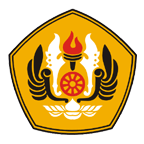Antibacterial Activity Test of Olive Leaf (Olea europaea L.) Extract Eyes Ointment on The Growth of Staphylococcus aureus
Abstrak
Kata Kunci
Teks Lengkap:
PDFReferensi
M. Tehamen, L. Rares, and W. Supit, “Gambaran Penderita Infeksi Mata di Rumah Sakit Mata Manado Provinsi Sulawesi Utara Periode Juni 2017 - Juni 2019,” e-CliniC, vol. 8, no. 1, Dec. 2019.
H. Eguchi et al., “Diagnostic Approach to Ocular Infections Using Various Techniques From Conventional Culture to Next-Generation Sequencing Analysis,” Cornea, vol. 36, no. 1, pp. S46–S52, Nov. 2017.
B. Sherwal and anant kumar Verma, “Epidemiology of Ocular Infection Due to Bacteria and Fungus – A Prospective Study,” JK Science : Journal of Medical Education & Research, vol. 10, Oct. 2008.
N. Wang, Q. Yang, Y. Tan, L. Lin, Q. Huang, and K. Wu, “Bacterial Spectrum and Antibiotic Resistance Patterns of Ocular Infection: Differences between External and Intraocular Diseases,” J Ophthalmol, vol. 2015, 2015.
Anonymous, Farmakope Indonesia, 3rd ed. Jakarta: Departemen Kesehatan Republik Indonesia, 1979.
Abu Muhammad Faris al-Qiyanji and Shin She Suparisno, Kembali Ke Alam, Khasiat & Manfaat Tanaman Berkhasiat Obat. Naashirussunnah, 2015.
L. Sari, “Pemanfaatan Obat Tradisional Dengan Pertimbangan Manfaat Dan Keamanannya,” Pharmaceutical Sciences and Research, vol. 3, no. 1, pp. 1–7, Apr. 2006.
E. R. Utami, “Antibiotika, Resistensi, dan Rasionalitas Terapi,” el–Hayah, vol. 1, no. 4, Apr. 2012.
B. Barbaro et al., “Effects of the olive-derived polyphenol oleuropein on human health,” Int J Mol Sci, vol. 15, no. 10, pp. 18508–18524, 2014.
N. Harun, E. Herlina, and R. Siti Rahmah Kurnia, “Antihyperglycemic of Olive Leaf (Olea europaea L.) Ethanol Extract in Obesity Diabetic Male Mice (Mus musculus),” Atlantis Press International B.V, 2021.
S. Himour, A. Yahia, and H. Belattar, “Oleuropein and Antibacterial Activities of Olea europaea L. Leaf Extract,” European Scientific Journal, ESJ, vol. 13, no. 6, p. 342, Feb. 2017.
E. S. Sulasmi, L. A. Nugraha, M. S. Sari, and Suhadi, “Skrining Fitokimia Dan Analisis Kromatografi Lapis Tipis Dari Senyawa Aktif Kalakai (Stenochlaena palustris (Burm.F) Beddome) Di Taman Nasional Ba;uran,” Prosiding Seminar Nasional VI Hayati, vol. 6, pp. 129–137, 2018.
A. Najib, A. Malik, A. R. Ahmad, V. Handayani, R. A. Syarif, and R. Waris, “Standardisasi Ekstrak Air Daun Jati Belanda Dan Daun Jati Hijau,” Jurnal Fitofarmaka Indonesia, vol. 4, no. 2, pp. 241–245, 2018.
Isti Nurfaizah, Desy Nawangsari, and Dina Febrina, “Formulasi dan Uji Sifat Fisik Sediaan Salep Ekstrak Etanol Rimpang Kunyit (Curcuma longa L.) dalam Berbagai Basis,” in Prosiding Seminar Nasional Penelitian Dan Pengabdian Kepada Masyarakat (SNPPKM 2021), Lembaga Penelitian dan Pengabdian Kepada Masyarakat (LPPM) Universitas Harapan Bangsa, 2021.
Elmitra, Dasar-dasar Farmasetika dan Sediaan Semi Solid. Yogyakarta: Deepublish , 2017.
Agoes Goeswin, Sediaan Farmasi Steril. Bina Rupa Aksara, 2009.
D. Pratimasari, N. Sugihartini, and T. Yuwono, “Evaluasi Sifat Fisik dan Uji Iritasi Sediaan Salep Minyak Atsiri Bunga Cengkeh Dalam Basis Larut Air,” Jurnal Ilmiah Farmasi, vol. 11, no. 1, pp. 9–15, Feb. 2015.
N. Lumentut, H. J. Edi, and E. M. Rumondor, “Formulasi dan Uji Stabilitas Fisik Sediaan Krim Ekstrak Etanol Kulit Buah Pisang Goroho (Musa acuminafe L.) Konsentrasi 12.5% Sebagai Tabir Surya,” Jurnal MIPA, vol. 9, no. 2, p. 42, 2020.
Anonymous, Farmakope Indonesia , 4th ed. Jakarta: Kementrian Kesehatan Republik Indonesia, 2020.
D. Hoole, “Finfish and Shellfish Bacteriology Manual Techniques and Procedures,” Parasitology, vol. 129, no. 3, pp. 362–362, Sep. 2004.
Y. Arista, N. Kumesan, P. V. Y. Yamlean, and H. S. Supriati, “Formulasi dan Uji Aktivitas Gel Antijerawat Ekstrak Umbi Bakung (Crinum asiaticum L.) Terhadap Bakteri Staphylococcus aureus Secara In Vitro,” 2013.
A. S. Habiba, P. D. Tilarso, and E. A. Putri, “Pengaruh Konsentrasi Karbomer-940 pada Sediaan Emulgel Minyak Zaitun dan Ekstrak Daun Kelor,” Jurnal Sains dan Kesehatan, vol. 4, no. 2, 2022
DOI: https://doi.org/10.24198/ijpst.v6i2.52663
Refbacks
- Saat ini tidak ada refbacks.
| Switch to English Back to Top |
| View My Stats Penerbit Universitas Padjadjaran
Jurnal ini terindeks di :Creative Commons Attribution :
Based on a work at http://jurnal.unpad.ac.id/ijpst/ |
 Indonesian Journal of Pharmaceutical Science and Technology
Indonesian Journal of Pharmaceutical Science and Technology




